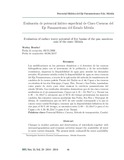| dc.rights.license | http://creativecommons.org/licenses/by-nc-sa/3.0/ve/ | es_VE |
| dc.contributor.author | Bracho, Yorley | |
| dc.date.accessioned | 2021-01-25T01:04:43Z | |
| dc.date.available | 2021-01-25T01:04:43Z | |
| dc.date.issued | 2021 | |
| dc.identifier.issn | 0798-2437 | |
| dc.identifier.uri | http://www.saber.ula.ve/handle/123456789/47239 | |
| dc.description.abstract | Las modificaciones en los patrones climáticos y el deterioro de las cuencas hidrográficas junto con el incremento de la población y de las actividades económicas, impactan la disponibilidad de agua para atender las demandas actuales. El presente estudio evaluó la disponibilidad de agua en cinco cuencas del Eje Panamericano, a través de la aplicación del método de transferencia de caudales de la cuenca patrón Puente del Diablo en el río Capaz a las cuencas en estudios de los ríos Mucujepe, Capaz, Frio, Tucaní y San Pedro, tomándose como punto de cierre para estas cuencas la carretera panamericana del estado Mérida. Los resultados obtenidos demuestran que de las cinco cuencas analizadas en el eje panamericano, Capaz con 5,11 - 14,70 m3/s y Tucaní con 4,91 - 11,93 m3/s arrojaron que el 95% del tiempo presentaran los mayores caudales, las restantes cuencas quedarían San Pedro, Rio Frio y Mucujepe de última. Si consideramos que un 10% de este caudal corresponde a lo que se conoce como caudal Ecológico, tenemos que la disponibilidad definitiva de los ríos para el 95% del tiempo, se encuentra entre 3,89 - 12,58 m3/s para el rio Capaz y de 4,10 – 10,22 m3/s para el rio Tucaní. | es_VE |
| dc.language.iso | es | es_VE |
| dc.publisher | Saber-ULA | es_VE |
| dc.rights | info:eu-repo/semantics/openAccess | es_VE |
| dc.subject | Potencial Hídrico | es_VE |
| dc.subject | Cuenca | es_VE |
| dc.subject | Método de transposición | es_VE |
| dc.subject | Caudal | es_VE |
| dc.title | Evaluación de potencial hídrico superficial de Cinco Cuencas del Eje Panamericano del Estado Mérida | es_VE |
| dc.title.alternative | Evaluation of surface water potential of Five Basins of the Pan American Axis of the State merida | es_VE |
| dc.type | info:eu-repo/semantics/article | es_VE |
| dcterms.dateAccepted | 08/06/2017 | |
| dcterms.dateSubmitted | 09/11/2016 | |
| dc.description.abstract1 | Changes in weather patterns and deterioration of watersheds together with increased population and economic activities impact the availability of water to meet current demands. The present study evaluated the water availability in five basins of the Pan American Axis. The study was made through the application of the method of transfer of flows of the Puente del Diablo basin in the Capaz river to the basins in studies of the Mucujepe, Capaz, Frio, Tucaní and San Pedro rivers, taking as a point of closure for these basins the Pan-American highway of the Mérida state. The obtained results show that of the five basins analyzed in the Pan - American axis, Capaz with 5,11 - 14,70 m3 / s and Tucaní with 4,91 - 11,93 m3 / s showed that 95% of the time presented the highest flows, the remaining basins would be San Pedro, Rio Frio and Mucujepe last. If we consider that 10% of this flow corresponds to what is known as Ecological flow, we have that the final availability of the rivers, 95% of the time, is between 3.89 - 12.58 m3 / s for the river Capable and 4,10 - 10,22 m3 / s for the Tucaní River. | es_VE |
| dc.description.colacion | 88-124 | es_VE |
| dc.identifier.depositolegal | 198102ME433 | |
| dc.publisher.pais | Venezuela | es_VE |
| dc.subject.facultad | Facultad de Ciencias Forestales y Ambientales | es_VE |
| dc.subject.institucion | Universidad de Los Andes | es_VE |
| dc.subject.institutoinvestigacion | Instituto Forestal LatinoAmericano (IFLA) | |
| dc.subject.keywords | Water potential | es_VE |
| dc.subject.keywords | Basin | es_VE |
| dc.subject.keywords | Transposition method | es_VE |
| dc.subject.keywords | Flow rate | es_VE |
| dc.subject.publicacionelectronica | Revista Forestal Latinoamericana | |
| dc.subject.seccion | Revista Forestal Latinoamerica: Artículos | es_VE |
| dc.subject.thematiccategory | Geografía | es_VE |
| dc.subject.tipo | Revistas | es_VE |
| dc.type.media | Texto | es_VE |


